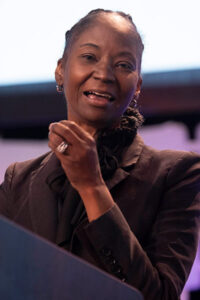
Building trust in science and healthcare is a prerequisite to improve cancer detection, treatment, and outcomes. Trust depends largely on personal and historical context, and not every breast cancer patient has had positive experiences.
“My journey began with 280,000 other women diagnosed with breast cancer, 27,000 of whom are African American women like me,” said Lori Wilson, MD, Professor of Surgery and Chief of Surgical Oncology, Howard University College of Medicine. “As a patient, that journey gives insight into the patient barriers and society’s approach to health. I am disproportionately represented in breast cancer diagnoses. And I am underrepresented in clinical trials. That must change.”
Dr. Wilson focused on advancing health equity through building trust during the first of two keynote presentations during Tuesday’s Special Session Trust in Science and Healthcare. The three-hour program also included panel discussions on improving equitable access to care and clinical trials. The entire session is available to registered SABCS attendees to watch on-demand until March 10, 2022.
Dr. Wilson had triple negative breast cancer (TNBC), which metastasized five years after her initial treatment. But unlike so many patients, she knew she had treatment options for metastatic disease, including clinical trials. Working with her care team, she found a trial and successful treatment.
“We must include health equity in the discussion,” she said. “Every one of the 281,000 women who will be diagnosed this year with breast cancer is unique. And they deserve equitable care. Everyone deserves a just and a fair opportunity to be their healthiest by removing all the barriers that make outcomes in healthcare different, whether those disadvantages are social, economic, or environmental. We have to do more together.”

Trust in science and in evidence-based healthcare is fundamental to care and outcomes, she continued, and trust is built on communication. Working from research into African American attitudes toward healthcare, Howard University Hospital has shifted its intake and information gathering to a conversational approach that starts with a life check, asking how the patient is doing, and actually listening to what they say.
“We thought it would be different, and it turned out to be transformational,” Dr Wilson said. “Our patient satisfaction scores went through the roof with a conversational approach, and we improved clinical trial enrollment. Our patients felt more linked to us, and we were able to establish a relationship with them. Adherence to treatment recommendations improved.”
The key to improving trust is to think outside conventional approaches, she continued. That starts with approaching patients as individuals, respecting their unique qualities, and presenting information in ways they can understand, manipulate, and use to make better choices.
“We must feel empowered to walk away from breast cancer care as we provide it today,” she said. “We must listen for every opportunity to make change, to identify opportunities to develop the next steps for our patients, our institutions, our communities. Together, we will advance toward health equity.”
The mortality difference between Black and White patients with breast cancer is very real. The North Carolina Breast Cancer Study (NCBCS) found that Black women tend to get more of the worse, more aggressive breast cancer types and less of the less aggressive types, said Charles Perou, PhD, who delivered the second keynote presentation. Dr. Perou is the May Goldman Shaw Distinguished Professor of Molecular Oncology and Professor of Genetics and Pathology & Laboratory Medicine at the University of North Carolina School of Medicine.
The same differences can be seen globally. Indigenous African women are overrepresented in triple negative breast cancer compared to White women in the US and Northern Europe. So are African American women.
A common variant at the TERT-CLPTM1L locus is associated with TNBC, he said. The variant allele is seen in 57% of African American women vs. 27% in White American women.
“In both African American and European women, it is a predisposition gene, regardless of ethnic background; however, it occurs with higher frequency in women of African descent,” Dr. Perou said. “Triple-negative disease has its own unique genetic susceptibility. It is its own disease.”
Societal factors also play a role. A phase 3 NCBCS analysis found that among women with commercial insurance who have HR+ breast cancer, Black women are 17% less likely to initiate endocrine therapy within 12 months of diagnosis. Black women were also less likely to be adherent to treatment and more likely to discontinue treatment.
“This is a very effective treatment, but it takes five years and has significant side effects,” Dr. Perou noted. “Patient surveys find a lower opinion of endocrine therapy among Black women, suggesting a lack of trust. We want to do something about this. The GETSET study is using text messages, phone calls, and more to try to improve adherence to endocrine therapy.”
There are also differences in HER2 targeting in older women. An analysis of trastuzumab use in HER2+ Medicare patients found that while significant numbers of both Black and White patients were not receiving appropriate treatment in all stages, only 56.3% of Stage III Black patients were on trastuzumab vs. 73.9% of White patients.
That picture changes in clinical trial settings. CALGB 40610 found no difference in response or survival by race for HER2+ patients on neoadjuvant paclitaxel-trastuzumab with or without lapatinib. CALGB 40603, a trial of neoadjuvant chemotherapy with or without carboplatin and bevacizumab in TNBC likewise found no difference in pCR or event-free survival by race.
“If you get the same treatments, you are going to have the same outcomes,” Dr. Perou said. “When patients go into clinical trials, they are more likely to get a complete set of treatments and more likely to get the best treatments available. I encourage all patients to enroll in clinical trials. It is both good for the patient and doing good for the benefit of society.”

